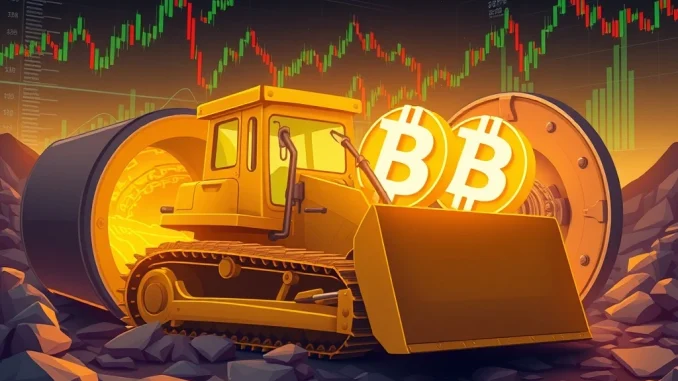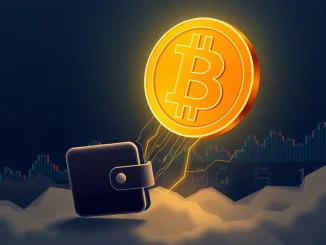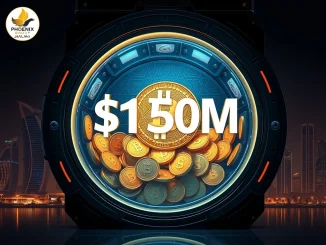
In the fast-evolving world of cryptocurrency, innovative strategies constantly emerge to reshape market dynamics. Today, we delve into a groundbreaking initiative by BSTR, a crypto-focused investment firm, which aims to significantly impact the **Bitcoin supply** by targeting previously inactive reserves. This bold move could redefine how we perceive Bitcoin’s scarcity and value.
What is BSTR’s Bulldozer Strategy for BTC Accumulation?
BSTR, co-founded by Sean Bill, has unveiled what it calls a ‘bulldozer strategy’ for **BTC accumulation**. This approach is designed to acquire Bitcoin by focusing on assets that have remained untouched for extended periods. Instead of competing for actively traded BTC, BSTR seeks out ‘dormant Bitcoin’ – those held in inactive wallets or institutional reserves that are not currently contributing to market liquidity.
- **Targeting Inactive Holdings:** The core idea is to convert non-liquid BTC into active investment vehicles.
- **Reducing Circulating Supply:** By moving these dormant coins into managed portfolios, the strategy aims to effectively reduce the active circulating supply of Bitcoin.
- **Enhancing Scarcity:** A reduction in available supply, especially as the 2025 halving event approaches, could amplify Bitcoin’s inherent scarcity premium.
How Does BSTR Identify and Acquire Dormant Bitcoin?
The success of the **BSTR strategy** hinges on its sophisticated methodology for identifying and acquiring these elusive assets. The firm leverages advanced data analytics and algorithmic tools to pinpoint patterns in transaction data. This allows them to detect Bitcoin held in cold storage or by entities that have shown no recent activity.
BSTR forms partnerships with data analytics providers to achieve this. These partnerships enable them to acquire BTC at potentially discounted rates, prioritizing coins that have not been transacted in extended periods. This method allows BSTR to bypass short-term market volatility, establishing a cost-effective pathway for investors to gain exposure to BTC while simultaneously supporting broader **crypto market liquidity** by activating previously inert assets.
What are the Market Implications of Activating Dormant Bitcoin?
The activation of **dormant Bitcoin** has significant implications for the overall market. Analysts suggest that reducing the circulating supply through targeted accumulation could enhance BTC’s scarcity premium. This concept becomes increasingly relevant as institutional adoption reshapes market structures and the next halving event draws closer.
BSTR’s focus on dormant reserves also highlights the growing importance of ‘active supply’ in crypto markets. This metric distinguishes frequently traded BTC from inert assets. By curbing the active supply, the firm anticipates creating upward price momentum through constrained availability. This aligns with macroeconomic signals and on-chain analytics, guiding purchases into structured investment vehicles designed to generate alpha across market cycles.
Challenges and Criticisms of the BSTR Strategy
While the **BSTR strategy** presents a compelling vision, it is not without its challenges and critics. One primary concern is the reliance on the willingness of dormant BTC holders to sell their assets. Many long-term holders (‘hodlers’) view their Bitcoin as a generational asset, making them less likely to part with it, even at a discount.
- **Holder Reluctance:** Convincing long-term holders to sell their dormant reserves could be a significant hurdle.
- **Regulatory Scrutiny:** Large-scale accumulation efforts could attract increased regulatory attention, particularly as authorities monitor market concentration in digital assets.
- **Speculative Outcomes:** The ultimate impact on price and scarcity remains speculative, dependent on the scale of accumulation and broader market factors.
Despite these criticisms, proponents view the initiative as a response to structural inefficiencies in crypto markets. They argue that it addresses the underutilization of BTC that could otherwise exacerbate supply-side pressures during bear markets.
Bitcoin’s Evolving Role: Store of Value or Utility?
BSTR’s tactics intersect with broader discussions about Bitcoin’s evolving role. By emphasizing the conversion of dormant BTC into active investments, the firm contributes to narratives framing Bitcoin as a utility-driven asset capable of supporting diverse financial use cases. This aligns with trends in institutional adoption, where Bitcoin is increasingly integrated into traditional portfolio management frameworks.
The firm’s methodology aims to maintain a consistent flow of BTC into portfolios resistant to liquidation risks, ensuring returns regardless of prevailing market conditions. This strategic approach reinforces Bitcoin’s potential as a robust financial asset, moving beyond mere speculation towards practical applications in diversified investment portfolios.
Conclusion: A New Chapter for Bitcoin Supply Dynamics?
BSTR’s ‘bulldozer strategy’ represents a fascinating and potentially impactful development in the Bitcoin ecosystem. By systematically targeting **dormant Bitcoin** reserves, the firm aims to fundamentally alter the active **Bitcoin supply**, thereby enhancing its scarcity and potentially driving its value higher. While challenges related to holder willingness and regulatory oversight persist, the initiative underscores the growing sophistication of crypto investment strategies and Bitcoin’s evolving role in global finance. As we approach the next halving, BSTR’s approach could indeed write a new chapter in how we understand and value the world’s leading cryptocurrency.
Frequently Asked Questions (FAQs)
What exactly are ‘dormant Bitcoin reserves’?
Dormant Bitcoin reserves refer to BTC holdings that have remained untouched in wallets or institutional accounts for extended periods, often years, without any outgoing transactions. These are typically held by long-term investors or those who may have lost access to their wallets.
How does BSTR’s ‘bulldozer strategy’ differ from typical BTC accumulation?
Traditional accumulation often involves buying BTC from active exchanges, which can contribute to short-term price volatility. BSTR’s strategy specifically targets inactive, non-liquid BTC, aiming to reduce the active circulating supply and capitalize on underutilized assets, potentially at a discount.
Could this strategy significantly impact Bitcoin’s price?
Proponents believe that by reducing the active circulating supply of Bitcoin, especially with the upcoming halving, the strategy could enhance Bitcoin’s scarcity premium and create upward price momentum. However, the actual impact depends on the scale of successful accumulation and market adoption.
What are the main risks associated with BSTR’s strategy?
Key risks include the challenge of convincing dormant holders to sell, potential regulatory scrutiny over large-scale market concentration, and the speculative nature of the expected price appreciation. The success hinges on the firm’s ability to acquire a substantial amount of these inactive coins.
How does BSTR ensure its accumulated BTC is resistant to liquidation risks?
BSTR integrates macroeconomic signals with on-chain analytics to inform targeted acquisitions. The acquired BTC is then funneled into structured investment vehicles designed to generate alpha across market cycles, with an emphasis on maintaining consistent flow into portfolios resistant to liquidation risks, aiming for returns regardless of market conditions.
Who is Sean Bill, and what is his role in BSTR?
Sean Bill is the co-founder of BSTR, the crypto-focused investment firm behind the ‘bulldozer strategy.’ He is instrumental in shaping the firm’s approach to accumulating Bitcoin by targeting dormant reserves within the cryptocurrency ecosystem.



